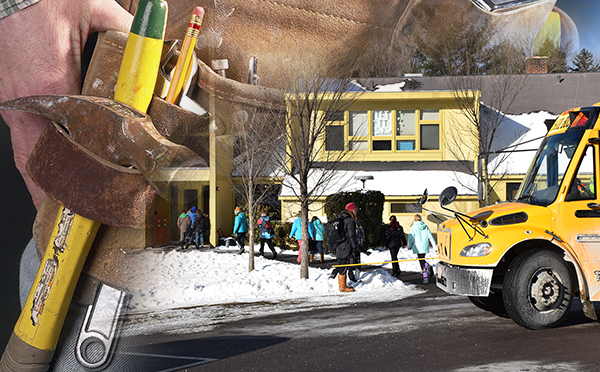“This is the community’s house. You have to take care of it,” said Cam Featherstonhaugh, who, with architect Dave Epstein, presented a series of quotes for building repairs for Warren Elementary School.
Both are based at the Burlington company TruexCullins, which was selected by the Warren School Board in early February to complete a string of construction projects at the school. They provided their preliminary cost estimates to the school board on March 8 which range from $1,802,346 to $4,728,336.
MUST PROCEED
Vermont School Boards Insurance Trust (VSBIT) recommended a series of repairs for Warren to complete in 2009 and Washington West Supervisory Union superintendent Brigid Scheffert Nease reported safety violations associated with the incomplete repairs to Secretary of Education Rebecca Holcombe last September. Holcombe told the board that they must proceed with repairs to the building and grounds as soon as possible.
The costs presented to the board were broken down into four categories, differing in their degree of necessity. Warren principal Beth Peterson said that the numbers viewed represent all possible projects but emphasized, “We have choices.” Newly elected board chair Matthew “Chicky” Staples said that the board, working with the school’s maintenance committee, must reach a “happy medium” with cost.
The first category consists of repairs related to health and safety, as well as code violations that require immediate action, totaling $1.8 million. Projects include a new air ventilation system ($650,000), new roofing ($214,000) and a new gym floor ($73,000).
CODE VIOLATIONS
The second category contains materials and systems at or near the end of their lifespans or items that would produce significant energy efficiency and totaled $2 million. Projects include a digital control system for heating, ventilation and air conditioning ($180,000), replacement of suspended ceilings ($89,000), new classroom flooring ($227,000) and new interior lighting fixtures, as current classroom lighting systems are “inappropriate technologies for a modern school,” Featherstonhaugh said.
The TruexCullins team also said replacing the school’s 46-year-old propane boiler with an energy efficient wood pellet system was needed ($96,000) and would allow the school to save roughly 40 percent in fuel costs. They suggested additional remedies for containing heat within the building, such as an external air barrier system or “envelope” ($98,000) and the replacement of windows ($189,000).
The third category relates to projects for which “there is a potential for an improved educational experience,” according to the firm’s document that listed costs. It totals $373,000 and some projects include an $80,000 partition that would separate the library from the hallway and replacement of the hot water heater, floor drains, cubbies and hooks.
VERY VARIABLE
The final category contains two additions to the building that Featherstonhaugh said “are to improve security,” totaling $513,000, including an addition to the front office ($264,000).
Epstein and Featherstonhaugh said that repairs in the first category would get everything up to code, but that “code is not this line in the sand—it’s very variable.” They added that the school would still see deficiencies that would require considering options in the second category.
The overall cost will also include “soft costs” for legal fees, permits and the like, as well as a year of cost escalation, a 10 percent owner’s contingency in the case that additional projects are needed along the way and a 15 percent design contingency, which would “take the place of unnoticed things” and would be “padded against the human factor.”
ONE SHOT
With a bond, Featherstonhaugh said, schools typically acquire them every 20 years or so, meaning Warren Elementary School has “one shot to do it and it’s important to get it right.” He added that if they could not afford certain projects at this time, they could use their reserve fund for purchases at a later date. Board members said that their reserve fund contains $16,000 for this year.
Board member and newly elected clerk Adam Greshin said that if the bond was $3 million spread over the course of 20 years, it would total about $450 to $500 yearly for a Warren home valued at $300,000. He said that Warren residents who struggle to pay their tax bill may not be supportive, especially if they do not have children attending the school.
Featherstonhaugh said, “If the community was forward thinking enough to choose all the items on the list,” the vote may pass.
The school’s building and maintenance committee will meet this Thursday, March 10, to discuss the options and a bond vote would most likely occur in April. The school board and TruexCullins will also host community forums in order to demonstrate why the repairs are needed.







